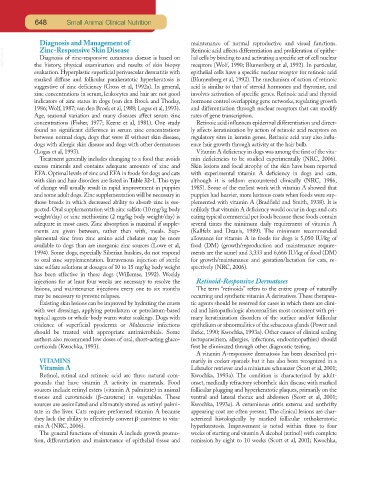Page 626 - Small Animal Clinical Nutrition 5th Edition
P. 626
648 Small Animal Clinical Nutrition
Diagnosis and Management of maintenance of normal reproductive and visual functions.
Zinc-Responsive Skin Disease
VetBooks.ir the history, physical examination and results of skin biopsy Retinoic acid affects differentiation and proliferation of epithe-
Diagnosis of zinc-responsive cutaneous disease is based on
lial cells by binding to and activating a specific set of cell nuclear
receptors (Wolf, 1990; Blumenberg et al, 1992). In particular,
evaluation. Hyperplastic superficial perivascular dermatitis with epithelial cells have a specific nuclear receptor for retinoic acid
marked diffuse and follicular parakeratotic hyperkeratosis is (Blumenberg et al, 1992). The mechanism of action of retinoic
suggestive of zinc deficiency (Gross et al, 1992a). In general, acid is similar to that of steroid hormones and thyroxine, and
zinc concentrations in serum, leukocytes and hair are not good involves activation of specific genes. Retinoic acid and thyroid
indicators of zinc status in dogs (van den Broek and Thoday, hormone control overlapping gene networks, regulating growth
1986; Wolf, 1987; van den Broek et al, 1988; Logas et al, 1993). and differentiation through nuclear receptors that can modify
Age, seasonal variation and many diseases affect serum zinc rates of gene transcription.
concentrations (Fisher, 1977; Keene et al, 1981). One study Retinoic acid influences epidermal differentiation and direct-
found no significant difference in serum zinc concentrations ly affects keratinization by action of retinoic acid receptors on
between normal dogs, dogs that were ill without skin disease, regulatory sites in keratin genes. Retinoic acid may also influ-
dogs with allergic skin disease and dogs with other dermatoses ence hair growth through activity at the hair bulb.
(Logas et al, 1993). Vitamin A deficiency in dogs was among the first of the vita-
Treatment generally includes changing to a food that avoids min deficiencies to be studied experimentally (NRC, 2006).
excess minerals and contains adequate amounts of zinc and Skin lesions and focal atrophy of the skin have been reported
EFA.Optimal levels of zinc and EFA in foods for dogs and cats with experimental vitamin A deficiency in dogs and cats,
with skin and hair disorders are listed in Table 32-1. This type although it is seldom encountered clinically (NRC, 1986,
of change will usually result in rapid improvement in puppies 1985). Some of the earliest work with vitamin A showed that
and some adult dogs. Zinc supplementation will be necessary in puppies had heavier, more lustrous coats when foods were sup-
those breeds in which decreased ability to absorb zinc is sus- plemented with vitamin A (Bradfield and Smith, 1938). It is
pected. Oral supplementation with zinc sulfate (10 mg/kg body unlikely that vitamin A deficiency would occur in dogs and cats
weight/day) or zinc methionine (2 mg/kg body weight/day) is eating typical commercial pet foods because these foods contain
adequate in most cases. Zinc absorption is maximal if supple- several times the minimum daily requirement of vitamin A
ments are given between, rather than with, meals. Sup- (Kallfelz and Dzanis, 1989). The minimum recommended
plemental zinc from zinc amino acid chelates may be more allowance for vitamin A in foods for dogs is 5,050 IU/kg of
available to dogs than are inorganic zinc sources (Lowe et al, food (DM) (growth/reproduction and maintenance require-
1994). Some dogs, especially Siberian huskies, do not respond ments are the same) and 3,333 and 6,666 IU/kg of food (DM)
to oral zinc supplementation. Intravenous injection of sterile for growth/maintenance and gestation/lactation for cats, re-
zinc sulfate solutions at dosages of 10 to 15 mg/kg body weight spectively (NRC, 2006).
has been effective in these dogs (Willemse, 1992). Weekly
injections for at least four weeks are necessary to resolve the Retinoid-Responsive Dermatoses
lesions, and maintenance injections every one to six months The term “retinoids” refers to the entire group of naturally
may be necessary to prevent relapses. occurring and synthetic vitamin A derivatives.These therapeu-
Existing skin lesions can be improved by hydrating the crusts tic agents should be reserved for cases in which there are clini-
with wet dressings, applying petrolatum or petrolatum-based cal and histopathologic abnormalities most consistent with pri-
topical agents or whole-body warm water soakings. Dogs with mary keratinization disorders of the surface and/or follicular
evidence of superficial pyoderma or Malassezia infections epithelium or abnormalities of the sebaceous glands (Power and
should be treated with appropriate antimicrobials. Some Ihrke, 1990; Kwochka, 1993a). Other causes of clinical scaling
authors also recommend low doses of oral, short-acting gluco- (ectoparasitism, allergies, infections, endocrinopathies) should
corticoids (Kwochka, 1993). first be eliminated through other diagnostic testing.
A vitamin A-responsive dermatosis has been described pri-
VITAMINS marily in cocker spaniels but it has also been recognized in a
Vitamin A Labrador retriever and a miniature schnauzer (Scott et al, 2001;
Retinol, retinal and retinoic acid are three natural com- Kwochka, 1993a). The condition is characterized by adult-
pounds that have vitamin A activity in mammals. Food onset, medically refractory seborrheic skin disease with marked
sources include retinyl esters (vitamin A palmitate) in animal follicular plugging and hyperkeratotic plaques, primarily on the
tissues and carotenoids (β-carotene) in vegetables. These ventral and lateral thorax and abdomen (Scott et al, 2001;
sources are assimilated and ultimately stored as retinyl palmi- Kwochka, 1993a). A ceruminous otitis externa and unthrifty
tate in the liver. Cats require preformed vitamin A because appearing coat are often present. The clinical lesions are char-
they lack the ability to effectively convert β-carotene to vita- acterized histologically by marked follicular orthokeratotic
min A (NRC, 2006). hyperkeratosis. Improvement is noted within three to four
The general functions of vitamin A include growth promo- weeks of starting oral vitamin A alcohol (retinol) with complete
tion, differentiation and maintenance of epithelial tissue and remission by eight to 10 weeks (Scott et al, 2001; Kwochka,

